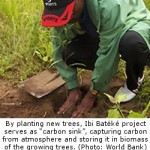
This reduction, however, comes at a price; the above measures also generate substantial negative consequences. Achieving sustainable fishery, for example, would require years of large limitations put on catches, which, in turn, would have an enormous impact on the livelihoods of fishermen the world over. Sustainable agricultural methods demand large investments, causing higher agricultural prices. And many people enjoy eating meat; they would experience a sense of loss when having to cut down on much of their meat consumption. Incidentally, these adjustments in consumption patterns could not be enforced by government. Citizens would have to make such a choice for themselves, whereby product pricing and information about alternative options would play a role.
The PBL is not the first to indicate possible options, but a quantitative analysis of the effects of such options has not been conducted before. The analyzed options also have been mentioned in many recent studies, such as the Global Biodiversity Outlook 3 of the Secretariat of the Convention on Biological Diversity (SCBD). In its analysis of the combination of options, the PBL avoided any overly extreme ambitions, and assumed development angles that seemed feasible. The researchers did not define the exact specifications of concrete measures.
Integral Approach Delivers the Most
Separately, the described options offer only limited possibilities for combating biodiversity loss. Most address just one or some of the causes of biodiversity loss. Certain options even counter each other. In addition, options can have negative effects on other issues, such as food security. In this study, the PBL shows that a combined approach would deliver the largest benefits. The effects of a specific combination of measures have been calculated, to demonstrate their combined result. Many other combinations could also be envisioned, possibly leading to larger or smaller results than the currently calculated halving of the rate of biodiversity loss.
Biodiversity loss presents a large political and societal task, both in individual countries and internationally. Global collaboration is crucial between countries and between UN organizations such as UNEP (biodiversity), FAO and UNFF (food, forestry), IPCC and UNFCCC (climate), UNDP (development), and WHO (health). As only such collaborations could achieve a global, integral approach. The Conference of the Parties (COP10) of the Convention on Biological Diversity (CBD) in Nagoya is intended to give a push in this direction.
Information About and During COP10
During the COP10 event, the PBL will maintain a web dossier, which can be accessed from mid-October on www.pbl.nl/en > click on dossier COP10 Nagoya.
Original Work:
Title of the Report: “Rethinking Global Biodiversity Strategies: Exploring Structural Changes in Production and Consumption to Reduce Biodiversity Loss”
Authors: B. ten Brink; S. van der Esch; T. Kram; M. van Oorschot; R. Alkemade; R. Ahrens; M. Bakkenes; J. Bakkes; M. van den Berg; V. Christensen; J. Janse; M. Jeuken; P. Lucas; T. Manders; H. van Meijl; E. Stehfest; A. Tabeau; D. van Vuuren; H. Wilting
Click here to read the Full Report:
About Netherlands Environmental Assessment Agency (PBL)
The Netherlands Environmental Assessment Agency (PBL) is the national institute for strategic policy analysis in the field of environment, nature and spatial planning. The PBL contributes to improving the quality of political and administrative decision-making by conducting outlook studies, analyses and evaluations in which an integrated approach is considered paramount. Policy relevance is the prime concern in all their studies. The PBL conducts solicited and unsolicited research that is both independent and always scientifically sound. For more information, visit www.pbl.nl.
Source: PBL Press Release dated October 5, 2010.














